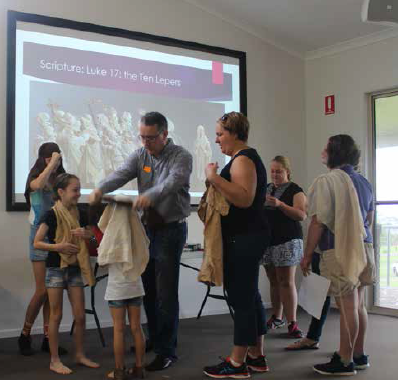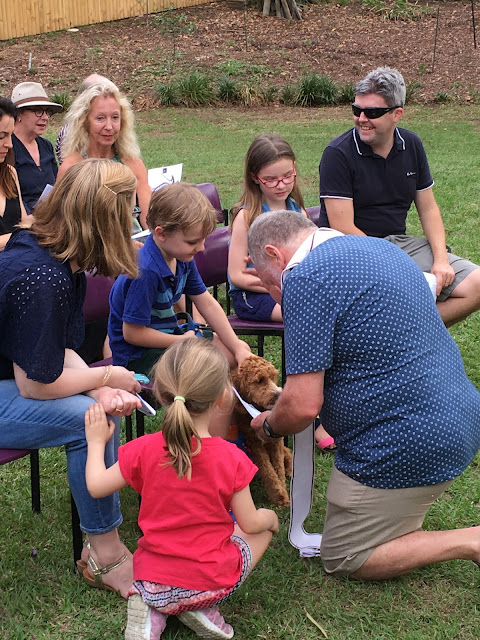How to do an Intergenerational Learning Event; (or Thank You Dalby!)
Recently, I was invited to speak at a new event for Dalby parish - a parish camp. Actually, a parish camp is not a new idea, and nor was it for Dalby, but it had been a long time since their last one. So it seemed like a new thing all over again.
St John's Dalby is a parish which I frankly like a LOT. Last year they funded, recruited and appointed Annabel Harth as a professional 'Young Families Minister' (a stipendiary lay minister, in Churchspeak). This showed that they were serious about engaging with families with young children, both inside and outside the parish. This has led to all kinds of exciting experiments, including the re-establishment of a parish camp aimed at all ages.
"Intergenerational" has been a buzzword for a while now in Christian ministry circles, so it's important to understand that it does NOT mean 'children's activities which adults are invited to watch and/or supervise'. It really means activities where, over the course of the event, there is something for every age group, and importantly, there is the opportunity for interaction between people in different age groups.
An American writer and speaker by the name of John Roberto is an expert in this area, and last year I was fortunate enough to spend a few days at a conference in Sydney with him. Among lots of good advice and resources, John gave me a great idea for a structure for an intergenerational event where we want learning to happen (as opposed to intergenerational fun or intergenerational service, which are other great things for a church to do):
1. Gathering. After signing in etc and having some food if possible, we provide an overview of the event, and lead the group in prayer and song.
2. An all-ages opening experience, so that everyone starts on the same level.
3. An in-depth learning experience (or series of experiences).
4. A whole-group sharing experience, where groups report back on what they have done and learned.
5. Reflection and home application.
6. Closing prayer service / song.
With this basic structure in mind, I created a Powerpoint to keep us all on track and prepared the various activities with which the group would explore the camp theme of "Thankfulness" (which is a great theme for this kind of event!)
So without going into too much detail, the order went something like this:
1. Welcome / intro.
2. Sing 'Give thanks with a grateful heart.'
3. Getting to know you (GTKY) activity using picture cards; sharing why you chose the card with a partner.
4. Watch YouTube video: 'A good day' by Br David Steindl-Rast, keeping a list of all the things mentioned or shown which we can be thankful for.
5. Fill in a Y-chart handout on Thankfulness and share.
6. Dramatic presentation of the Gospel (Luke 17: the ten lepers) with kids in simple costumes.
7. Homily from me expanding on the Gospel passage, based on being thankful with our hearts, heads and hands.
8. Fill in 'Gratitude journal' handouts, based on research showing that formally listing all the things for which you can be thankful actually improves mental health.
9. Explanation of 'warm fuzzy' notes and envelopes. The group started writing warm fuzzies then and there but I encouraged them to keep it going over the course of the whole weekend.
(Morning tea break)
10. Group was split into 'generations' which I defined as 'being born in each decade', which worked well. Each 'decade group' took butchers paper, blutacked it to a wall and drew an outline of one of their members. They then illustrated the outline with the 'look of the decade' (e.g. flower child for the 60s), and wrote around it all the reasons why they were thankful they were born in that decade.
11. Each group reported back to the whole group on the things listed and time was given for people to walk around and look at the other groups' efforts.
12. Activity tables. The following options were given (some of which were taken from 'Get Messy', the Messy Church magazine):
- Write Warm Fuzzies and deliver them to envelopes.
- Light a votive candle in a sand-bowl and give thanks.
- Create fake leprosy sores with bubble wrap, double sided sticky tape and yellow body-paint.
- Colour in happy / sad leper paper dolls.
- Paint a stone as a ‘thank you’ paperweight.
- Create a playdough sculpture symbolising thanks (and write a note to explain it).
13. Regather and reflect on what people chose to do and create.
14. Sing 'If I were a butterfly'.
15. Final prayer of thanksgiving from the APBA (p.16).
And after a few final words of thanks (especially to Fr Tom Bower for inviting me) and blessing each other, we headed off for lunch, and then for me, the drive back to Brisbane.
I must say I was very happy with the content and process of my half-day of input, and I came away with a few random observations including:
- The generosity with which the different generations present treated each other throughout;
- The oldest attendees were born in the 1930s; the youngest since 2000. We had no-one present born in the 1980s or 1990s, which again suggested a wider need to strategise on regaining the missing generations in our Church;
- the fact that the youngest group were very happy they grew up with digital technology while the older groups were happy they had grown up without it!
- the fun that was had by different ages doing art and craft together;
- the enthusiasm of the group for expressing their thanks to each other, and I suspect quite a lot of thanks was sent the way of their priest, which is excellent.
I would encourage other parishes to consider whether holding a parish camp may be a timely way of reigniting their community, and our AYCF team at St Francis College Milton would be very happy to assist you with any aspect of a parish family camp or a similar project.
Peace in Christ, Jonathan K.




Comments
Post a Comment